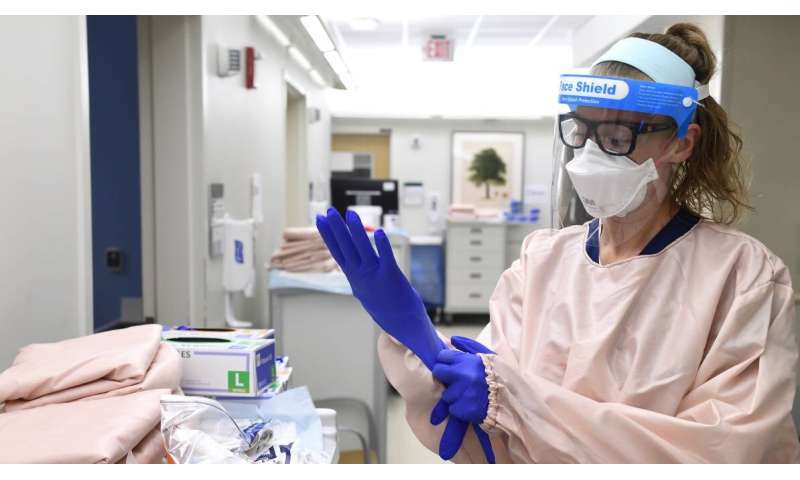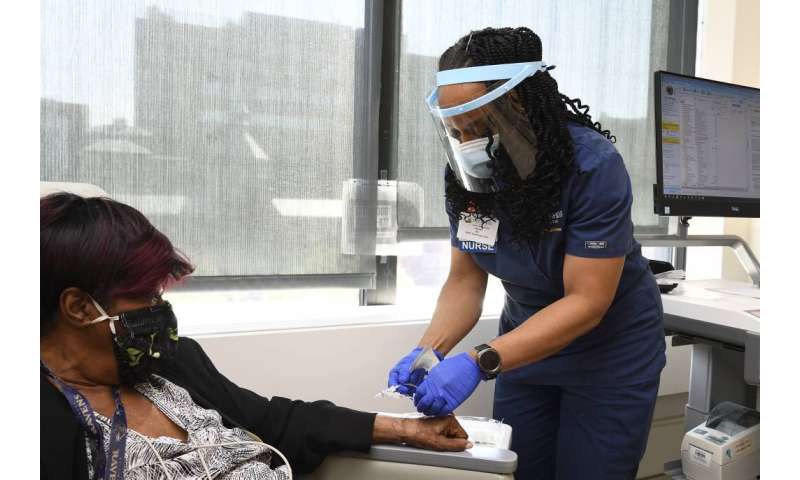
As the first waves of coronavirus cases swept across the U.S. in March, clinical nurse specialist Michelle Patch was transitioning into a full-time faculty role at the Johns Hopkins School of Nursing. She abruptly pivoted, joining the core of Johns Hopkins Medicine’s pandemic response as an operations chief of its unified command center. Through spring and summer, she worked on a team to untangle a knot of logistical puzzles, like how to allocate personal protective equipment evenly across the institution.
“It was constant maneuvering and a lot of stress,” Patch says. “And that feeling of personal responsibility.”
This is a transformational time for the field of nursing. While the pandemic has rearranged nearly every aspect of health care, the impacts on nursing may be the most profound—given that nurses represent 80% of the industry’s workforce, and demand for their skills is at a peak.
“Often nurses are invisible in the discussion of health care, but the COVID-19 pandemic has brought to light the indisputable need for nurses,” says Patricia Davidson, dean of the Johns Hopkins School of Nursing. It’s become clear, she says, that “nurses provide the bulk of care and assume the brunt of danger that comes with stemming a worldwide health crisis.”
Above all, the pandemic has demanded flexibility. With patient numbers increasing and hospitals strained, many nurses have stepped directly onto the frontlines of the COVID-19 response or shifted to fill other voids the pandemic has created—often working longer, unpredictable hours. In some cases, nurses have crossed state lines to provide care, and retired nurses have returned to action. To maximize their utility, some changes have been necessary at the regulatory level, removing longtime barriers on both the modes and the scope of practice for nurses.
A telehealth revolution
For nurses, the quick adoption of telehealth technology—aided by the easing of federal restrictions on privacy and billing—was a necessary change to serve patients safely and efficiently during COVID-19.
Alexandra Morrel, nurse practitioner manager at the Student Health and Wellness Center on JHU’s Homewood campus, says the clinic shifted to predominantly telemedicine in the spring to help students who remained in and around Baltimore after the university transitioned to remote instruction and supporting those in states that permitted Maryland-based appointments.
The transition “was a little rough to begin with, learning all the nuances and the best ways to practice,” Morrel says, and her job became “almost fully administrative,” configuring workflows for the clinic.
While the number of in-person appointments is one the rise now—some conditions require it—Morrel has found that services like routine checks and follow-ups lend themselves naturally to telemedicine, saving time and increasing access.
Before the pandemic, nurse practitioner Jason Farley was embarking on the first fully telehealth-based study approved at Johns Hopkins, evaluating at-home treatment for sexually transmitted diseases including HIV/AIDS. At the time, he says, the concept of all-remote care seemed avant-garde.
“It really felt like we were pushing the envelope,” says Farley, who says his infectious disease practice is now 90% telehealth.
According to Davidson, the potential for telehealth expansion has been clear for many years but it took a pandemic to break resistance to it. “The uptake of telehealth has been a silver lining potentially moving us forward decades over a few short months,” she says.
Authority issues
Other regulatory barriers have come under the microscope, including laws that dictate the scope of work that advanced practice nurses—those with post-graduate education, including nurse practitioners and clinical nurse specialists—can perform.
At Johns Hopkins, Davidson has led a campaign called #ItCantWait, advocating to empower nurses to practice at the full capacity of their training and skills.

In the case of nurse practitioners, that means the right to “full practice authority” without physician oversight. Under that authority—currently permitted in 22 states and D.C.—nurse practitioners have autonomy to diagnose patients, order and interpret tests, and manage treatments, including prescribing controlled substances. In other states, something akin to a permission slip from a doctor is necessary for some of those practices.
The Hopkins campaign echoes similar calls this spring from the American Association for Nurse Practitioners and U.S. Secretary of Health and Human Services Alex Azar, all with the same goal: increase the flexibility of nurses to respond to the nation’s health crisis.
During the pandemic, five states have temporarily suspended existing practice agreements, according to the AANP, while others have tweaked restrictions or allowed executive orders to expire in order to grant nurses more authority. Other states haven’t moved.
The patchwork of responses reflects the national disharmony on the issue. Well before COVID-19, this was a contentious topic in health care policy debates. But some nursing advocates see the present as a make-or-break moment to press for more lasting changes.
“I can say with confidence that right now the world is watching us,” Davidson says. “We as nurses must grab hold of this opportunity to advocate for our profession and the protection of populations we serve.”
In recent memory, Hurricane Katrina and Hurricane Sandy similarly highlighted barriers preventing nurses from performing to the extent of their training. According to Roman Galperin, an associate professor of management at the Johns Hopkins Carey Business School, the “massively publicized shortages of physicians” during President Clinton’s health care reform in the 1990s and the advent of Obamacare also ushered in changes for nursing.
“The arguments were essentially the same,” Galperin says. “The nursing profession’s response was: ‘We are here, we have the skills, but we don’t have the rights.'”
Persistent debate
Changes to scope of practice in nursing can be politically sensitive, however, with major medical associations and state boards often tipping the scales in favor of the status quo.
“I’ve seen very strong arguments against giving nurse practitioners autonomy, usually citing safety and lack of expertise and training as reasons,” says Galperin, who has studied the rise of nurse practitioners in the context of retail clinics, such as urgent-care centers and clinics within drugstores.
Advocates for expanded nursing authority believe that resistance is rooted in outdated perceptions of nursing and in the desire to differentiate the roles of nurses and physicians.
“There can be a general culture image of a nurse being considered less of an expert professional,” Galperin says, though that perception of nurses often doesn’t correlate to “their actual skill sets.”
Farley says the issue often boils down to a “turf battle at the state level for access to patients,” while safety concerns have not proved valid. “Based on all I’ve seen and been privy to, there is no scientific evidence that quality of care is negatively impacted when provided by a nurse practitioner,” he says.
Patch says clinical nurse specialists like herself—a role that shares characteristics with nurse practitioners but is more oriented to outreach and education—have been waging the same kinds of battles, including lobbying for rights to write prescriptions without physician oversight. In the pandemic, this flexibility could be critical when resources are low. Colleagues share stories, Patch says, of time squandered tracking down busy doctors in order to make minor tweaks to medicine orders they could have completed themselves.
“COVID-19 has brought to light that [empowering nurses] is something that would help patients, help families, and also help the practitioners we’re working with,” Patch says.
Patch also believes that COVID-19 has elevated the nursing profession by affirming the essential role nurses play during emergencies, and she’s hopeful to see lasting advances.
Source: Read Full Article






